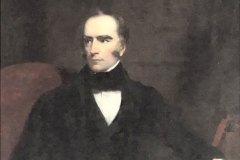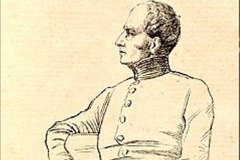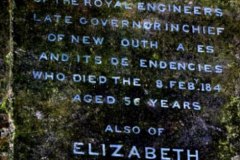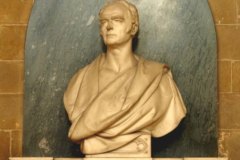(1790-1847) Soldier, Administrator & Governor-General
Gipps (Images 1 and 2) was the eldest son of the Rev George Gipps (1760-1802), rector of Ringwould, near Deal, and Susannah Gipps, nee Venn (?-1823). He was born into one of the leading families of late 18th century Canterbury. Great-uncle George Gipps (c1729-1800) was a wealthy self-made man who was an MP for the city. Uncle Henry Gipps (1757-1812) was a co-partner with great-uncle George and James Simmons (1741-1807) in Canterbury Bank (now part of Lloyds Bank) based in St Margaret’s Street.
In Canterbury the family stayed at 11 St Margaret’s Street (destroyed by enemy action in 1942) which great-uncle George had occupied. Gipps was a pupil at King’s School, Canterbury, from where he went to the Royal Military Academy, Woolwich, joining the Royal Engineers as Second Lieutenant in January 1809 and rising to be Lieutenant Colonel in 1841.
Military career
In 1811 he served in the Spanish peninsula and saw action in a number of engagements, being mentioned twice in despatches. From 1814 to 1817 he was in the Duke of Wellington’s army in the Netherlands and France but missed the Battle of Waterloo as he was arranging defences at Ostend. From 1824 to 1829 he served in the West Indies and it was representations he made over the emancipation of slaves that impressed the government with his capacity for civil business.
In 1830 Gipps married, in St Mary Bredin, Canterbury, Elizabeth Ramsay (c1797-1874), of Whitefriars, Canterbury, the daughter of Major-General George Ramsay of the Royal Artillery.
Administrative career
While in command of the Royal Engineers at Sheerness, Isle of Sheppey, he was appointed to two government commissions on electoral boundaries in Ireland and England. In 1834 he became private secretary to the Earl of Auckland, First Lord of the Admiralty. The following year he was on a commission to Canada inquiring into local grievances.
Governor-general
In 1837 Gipps was appointed governor-general of New South Wales, Australia. His remit covered most of Australia and from 1839 to 1841 this was extended to New Zealand. His time in charge of the rapidly-growing colonies proved difficult. He faced much opposition to his actions to protect the native population, his moves for land reform and his education policy. However, his policies were broadly appreciated by the British government and his term was extended beyond the usual six years until 1846.
The policy conflicts had taken its toll on his health but on his return to England he was seeking to take another role with the Royal Engineers. However, in February 1847 he died suddenly of a heart attack while staying with his sister Anne (1789-1865) and her husband George Taswell (c1785-1868) at their house on St Martin’s Hill, Canterbury. He was buried in the cloisters of Canterbury Cathedral [Image 3] and there is a memorial [Image 4] to him on the south wall of the cathedral nave.
- Gipps and his wife had one child, Reginald Ramsay Gipps (1831-1908) who joined the Scots Guards, was twice injured in the Crimean War and became a major-general and Military Secretary.
- Gippsland, an area to the east of present-day Melbourne, was named after Gipps by Polish explorer Paul Strzelecki.
Sources: Australian Dictionary Of Biography; Gipps (1996); Gentleman’s Magazine 1847, page 425; portrait at Image 1 is held by Mitchell Library NSW
JPD




